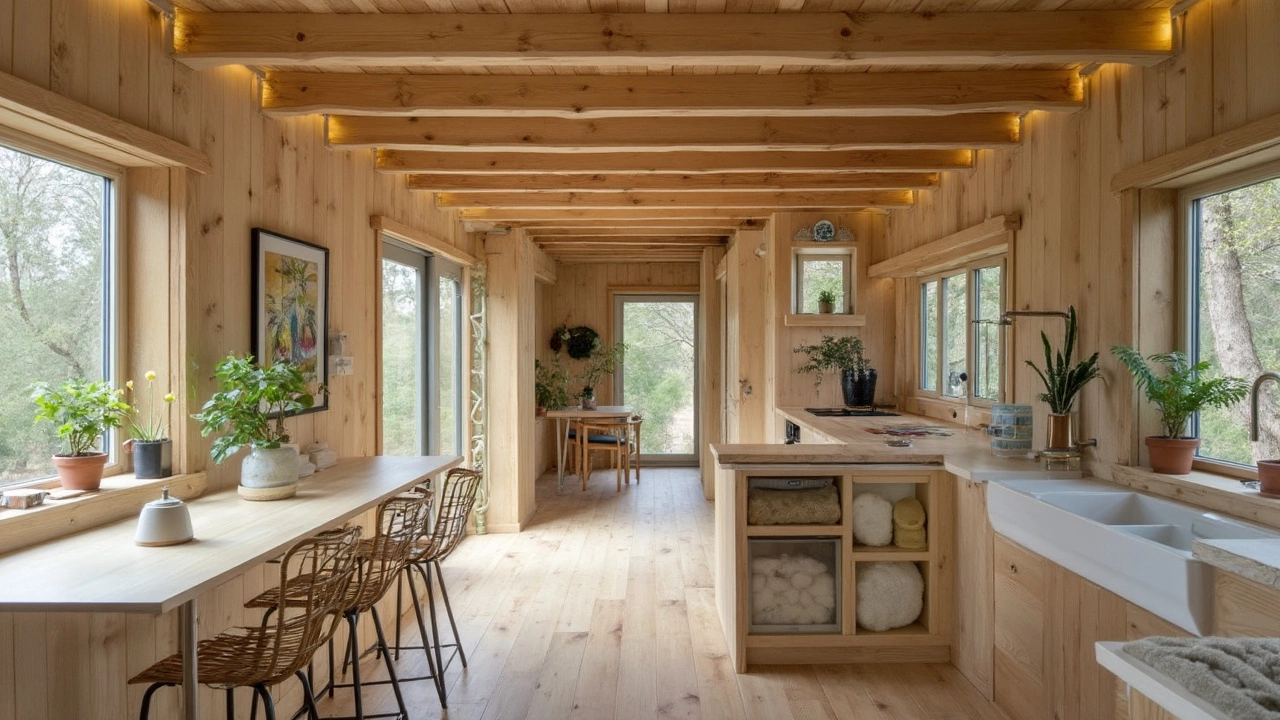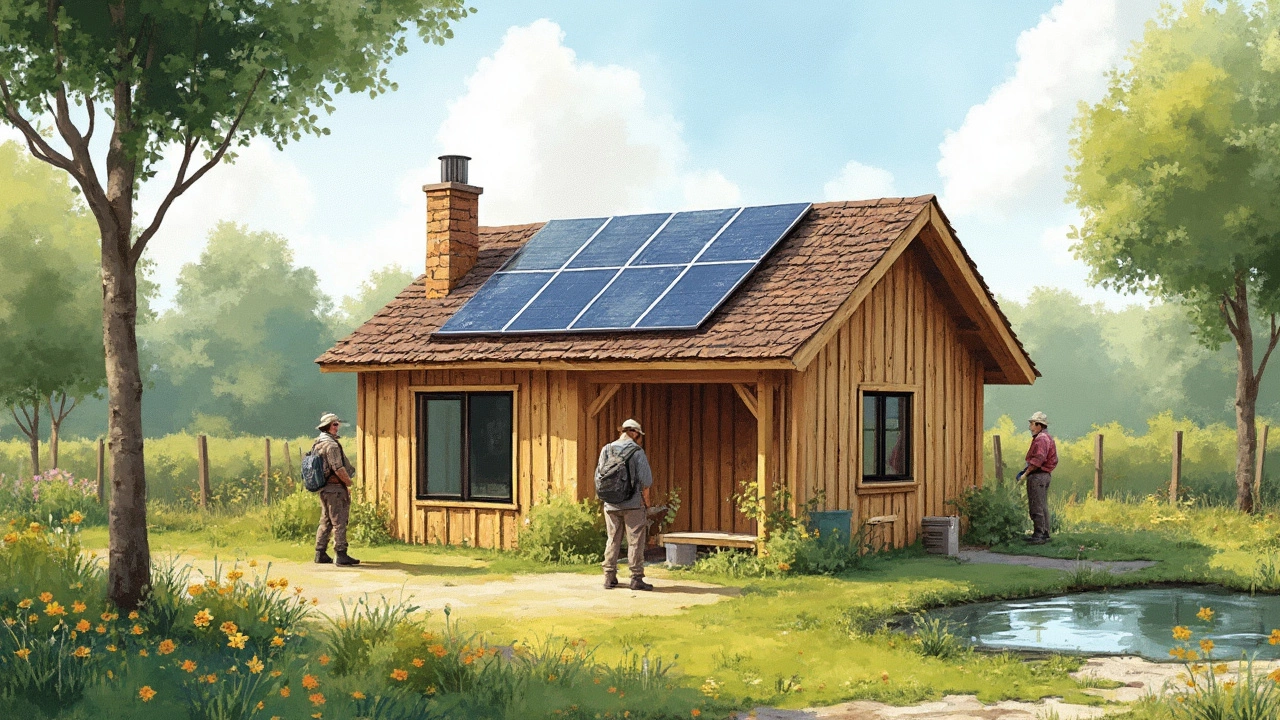Ever found yourself daydreaming about a cozy little cottage, sunlight on natural wood floors and Jasper the cat napping in the window? Now, toss in the idea of it being truly eco-friendly. Forget the picture-perfect magazine gloss—how do you actually make your small home gentle on the planet, without emptying your bank account? This isn’t about building an off-grid hideaway for millions, but honest, down-to-earth steps anyone can use to create a greener cottage—right from the way you shape the roof to what you put inside.
Planning Your Eco-Friendly Cottage: Where It All Begins
Before you even pick up a hammer, sit with a coffee (or, let’s be honest, a cold can of something) and really plan. Location is everything—south-facing windows in the Northern Hemisphere are like magic for free heating and light, if you design the cottage to soak up and trap the sun’s warmth. Possibly the single most crucial thing you can do: aim for a compact footprint. Smaller cottages aren’t just cute, but naturally use fewer resources. If your cottage is under 1,000 square feet, you’re already cutting energy, building materials, and future heating/cooling by leaps and bounds. According to the American Council for an Energy-Efficient Economy, homes under 1,000 square feet use 40% less energy on average than larger homes per capita. That's huge.
Now, don't brush aside site selection and orientation just because they sound dry. If you protect trees on your lot, they serve as natural air conditioning for decades—some studies show mature trees can cool a site by up to 5°F in summer. Keep enough distance from sensitive zones like wetlands, and always check if local regulations reward green construction. More and more towns offer fast-track permitting or tax breaks for sustainable designs—free money on the table, just for asking.
Another key tactic: sketch out spaces that multitask. That reading nook? It can be a guest spot, too. Built-in seating doubles as storage. Go for open-plan, flexible layouts to avoid boxed-in, wasteful dead space that so many houses (and, annoyingly, apartments) fall into. Planning is also the stage when you weigh renewable energy options—will you be installing a heat pump, solar panels, or water catchment? Get those future needs on paper now since adjustments get messy and expensive later.
Choosing the Right Materials: Build Smart From the Ground Up
The single most overlooked eco trick isn’t a gadget or system—it’s what you build with. Think locally sourced timber, reclaimed brick, or even straw bales. Seriously. Straw bales have been used for hundreds of years and they’re making a quiet comeback; they’re great insulators, cheaper than you expect, and lock away carbon instead of releasing it. Prefer wood? Pick FSC-certified lumber, which tells you the trees came from responsibly managed forests. Concrete is notoriously bad for the environment, but tiny tweaks in your mix (like adding fly ash, a byproduct from power plants) can slash its carbon footprint by 15 to 30% without changing its strength.
If you want another under-the-radar tip: look for recycled steel and insulation that’s made from denim, sheep’s wool, or even old newspapers (cellulose insulation). These aren’t just greener on paper—they’re cozy, easy for DIYers to work with, and have much fewer chemical off-gassing problems. And if you’re using paints, stains, and adhesives, stick with low-VOC or no-VOC versions. Conventional finishes can leach toxins into your home’s air for years. Your lungs (and, let’s be real, Jasper’s whiskers) will thank you.
When it comes to roofing, metal panels stand out—they last 50+ years, reflect heat away in summer, and are fully recyclable if one day you roof-surf into retirement. For siding, bamboo, untreated cedar, or even earth-friendly brick alternatives work well, both for looks and longevity. Here’s a quick glance at how some popular materials stack up:
| Material | Avg. Lifespan (years) | Embodied Carbon (kgCO2/m2) | Recyclable |
|---|---|---|---|
| Metal Roof | 50+ | Low-Medium | Yes |
| Straw Bale | 100+ | Very Low | Biodegradable |
| Reclaimed Brick | 100+ | Low | Yes |
| Vinyl Siding | 30 | High | No |

Make Your Cottage Energy Efficient: Tricks That Actually Work
This is where the green rubber hits the road: energy use. The best technology is often what you don’t notice every day, like super-thick insulation or triple-glazed windows that make outside storms barely a whisper. These upgrades can cut heating and cooling needs by 50%, based on recent U.S. Department of Energy data. Get serious about air sealing—think foam tape, caulk, and those clever little door sweeps. A single half-inch gap under an exterior door can leak as much energy as leaving a small window open year-round.
Don’t cheap-out on windows. Look for ENERGY STAR-certified glazing with a low U-factor (aim for 0.3 or less). South-facing windows should be large, with overhangs that block the high summer sun but let in winter rays. Tiny design tweaks—like painting walls a light color near those windows—can boost natural light so much you’ll rarely flick a light switch before sunset. Keep your roof style simple and dark for cold climates to soak up warmth, or pale and reflective for hot areas. If you want to get fancy, a green (planted) roof is off-the-charts for insulation, but it does mean extra maintenance—be ready for the occasional squirrel drama.
I installed a heat pump in my last place after doubting it could handle cold Canadian nights, but—surprise!—it worked even when it dropped below freezing. These compact wonders cool, heat, and even dehumidify, all while using way less energy than the old oil furnace my granddad loved so much. For hot water, check out hybrid heat pump water heaters; they're like a fridge working in reverse and use 60% less juice than standard models. And obviously, LED lighting is cheap and a no-brainer, but if you love mood lighting like I do, buy dimmable ones so every evening feels different. Here’s how much you could save on annual bills by going all-in:
| Feature | Standard Model (Annual Cost) | Eco-Friendly Model (Annual Cost) | Annual Savings |
|---|---|---|---|
| Heating | $850 | $340 | $510 |
| Lighting | $150 | $35 | $115 |
| Water Heating | $440 | $176 | $264 |
Solar panels? They’re far cheaper than even a few years ago (down to about $2.95 per watt installed, on average), and portable plug-and-play kits might be all you need if you’re keeping energy use minimal. If you want backup for cloudy spells, a small, ultra-efficient wood stove or direct-vent natural gas heater can work wonders in colder climates—just double check local air quality rules and burn only seasoned wood to cut pollution by over 70%.
Water, Waste, and the Finishing Touches
The not-so-glamorous bits matter, too. Capturing rainwater from your roof is legal in nearly every state (except Colorado, where you need a permit), and it’s a genius way to water plants or even flush toilets with minimum fuss. A basic barrel with mesh on top to keep out mosquitoes costs about $40. If you live where every drop counts, dig a little deeper with greywater systems that route water from sinks and showers out to your garden.
Composting toilets have gone from smelly cabin gimmicks to very real alternatives—modern models have fans and filters making them as odorless as any mainstream bathroom. If a bit expensive up front, they mean never flushing drinkable water down the drain again, saving up to 7,000 gallons per person each year.
For inside finishes, eco-friendly doesn’t mean ugly or weird. Go for reclaimed wood flooring—some suppliers specialize in old barn planks that are tougher than modern hardwood and give instant character. Cork tile (surprisingly durable with pets, so Jasper can run wild!) is made from tree bark that regrows, not cut trees. Need counters? There are beautiful composites made from recycled glass or even compressed papers, totally waterproof. Skip the granite shipped halfway across the globe. Even for decor, opt for natural fiber textiles, houseplants, and nontoxic cleaners. The Environmental Working Group’s database is fantastic for finding products that won’t make your indoor air worse than city smog. And when you’re ready to move in, all those little decisions add up. Eight out of ten buyers say green features make a place more appealing—and homes built to eco-standards can resell for as much as 7% more than conventional ones, according to a 2024 Redfin analysis.
Turns out, building an eco-friendly cottage isn’t out of reach or all-or-nothing. Each sustainable tweak, every smarter choice, stacks up. It’s a real home, lighter on the planet—and one Jasper can sunbathe in guilt-free, too.
